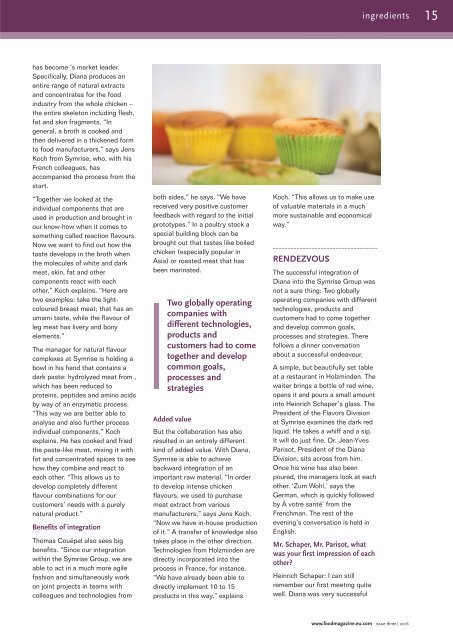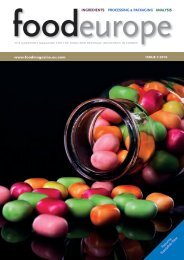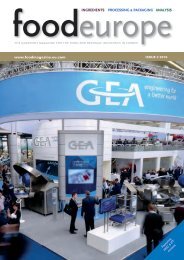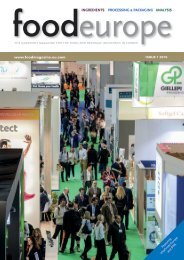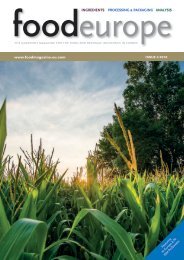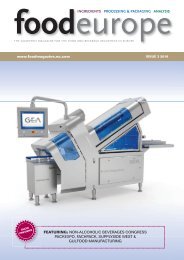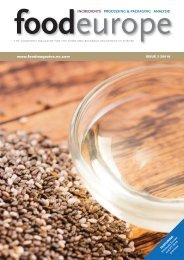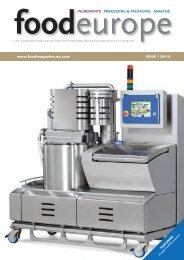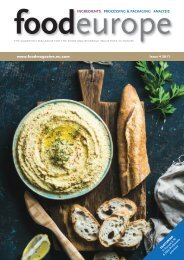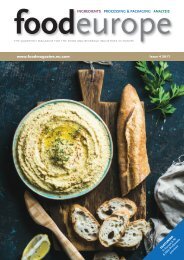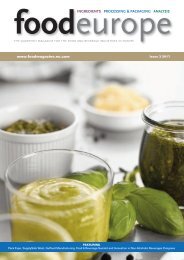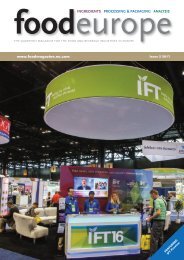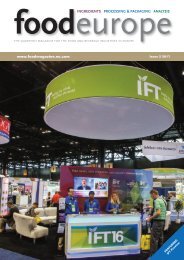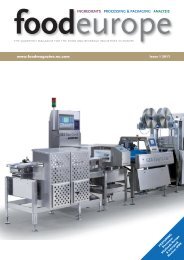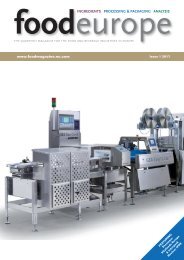Issue 3 2016
You also want an ePaper? Increase the reach of your titles
YUMPU automatically turns print PDFs into web optimized ePapers that Google loves.
ingredients 15<br />
has become ’s market leader.<br />
Specifically, Diana produces an<br />
entire range of natural extracts<br />
and concentrates for the food<br />
industry from the whole chicken –<br />
the entire skeleton including flesh,<br />
fat and skin fragments. “In<br />
general, a broth is cooked and<br />
then delivered in a thickened form<br />
to food manufacturers,” says Jens<br />
Koch from Symrise, who, with his<br />
French colleagues, has<br />
accompanied the process from the<br />
start.<br />
“Together we looked at the<br />
individual components that are<br />
used in production and brought in<br />
our know-how when it comes to<br />
something called reaction flavours.<br />
Now we want to find out how the<br />
taste develops in the broth when<br />
the molecules of white and dark<br />
meat, skin, fat and other<br />
components react with each<br />
other,” Koch explains. “Here are<br />
two examples: take the lightcoloured<br />
breast meat; that has an<br />
umami taste, while the flavour of<br />
leg meat has livery and bony<br />
elements.”<br />
The manager for natural flavour<br />
complexes at Symrise is holding a<br />
bowl in his hand that contains a<br />
dark paste: hydrolyzed meat from ,<br />
which has been reduced to<br />
proteins, peptides and amino acids<br />
by way of an enzymatic process.<br />
“This way we are better able to<br />
analyse and also further process<br />
individual components,” Koch<br />
explains. He has cooked and fried<br />
the paste-like meat, mixing it with<br />
fat and concentrated spices to see<br />
how they combine and react to<br />
each other. “This allows us to<br />
develop completely different<br />
flavour combinations for our<br />
customers’ needs with a purely<br />
natural product.”<br />
Benefits of integration<br />
Thomas Couëpel also sees big<br />
benefits. “Since our integration<br />
within the Symrise Group, we are<br />
able to act in a much more agile<br />
fashion and simultaneously work<br />
on joint projects in teams with<br />
colleagues and technologies from<br />
both sides,” he says. “We have<br />
received very positive customer<br />
feedback with regard to the initial<br />
prototypes.” In a poultry stock a<br />
special building block can be<br />
brought out that tastes like boiled<br />
chicken (especially popular in<br />
Asia) or roasted meat that has<br />
been marinated.<br />
Two globally operating<br />
companies with<br />
different technologies,<br />
products and<br />
customers had to come<br />
together and develop<br />
common goals,<br />
processes and<br />
strategies<br />
Added value<br />
But the collaboration has also<br />
resulted in an entirely different<br />
kind of added value. With Diana,<br />
Symrise is able to achieve<br />
backward integration of an<br />
important raw material. “In order<br />
to develop intense chicken<br />
flavours, we used to purchase<br />
meat extract from various<br />
manufacturers,” says Jens Koch.<br />
“Now we have in-house production<br />
of it.” A transfer of knowledge also<br />
takes place in the other direction.<br />
Technologies from Holzminden are<br />
directly incorporated into the<br />
process in France, for instance.<br />
“We have already been able to<br />
directly implement 10 to 15<br />
products in this way,” explains<br />
Koch. “This allows us to make use<br />
of valuable materials in a much<br />
more sustainable and economical<br />
way.”<br />
RENDEZVOUS<br />
The successful integration of<br />
Diana into the Symrise Group was<br />
not a sure thing: Two globally<br />
operating companies with different<br />
technologies, products and<br />
customers had to come together<br />
and develop common goals,<br />
processes and strategies. There<br />
follows a dinner conversation<br />
about a successful endeavour.<br />
A simple, but beautifully set table<br />
at a restaurant in Holzminden. The<br />
waiter brings a bottle of red wine,<br />
opens it and pours a small amount<br />
into Heinrich Schaper’s glass. The<br />
President of the Flavors Division<br />
at Symrise examines the dark red<br />
liquid. He takes a whiff and a sip.<br />
It will do just fine. Dr. Jean-Yves<br />
Parisot, President of the Diana<br />
Division, sits across from him.<br />
Once his wine has also been<br />
poured, the managers look at each<br />
other. ‘Zum Wohl,’ says the<br />
German, which is quickly followed<br />
by À votre santé’ from the<br />
Frenchman. The rest of the<br />
evening’s conversation is held in<br />
English.<br />
Mr. Schaper, Mr. Parisot, what<br />
was your first impression of each<br />
other?<br />
Heinrich Schaper: I can still<br />
remember our first meeting quite<br />
well. Diana was very successful<br />
www.foodmagazine.eu.com issue three | <strong>2016</strong>


